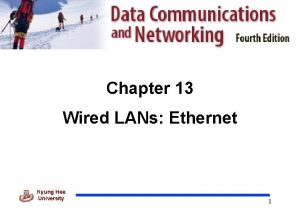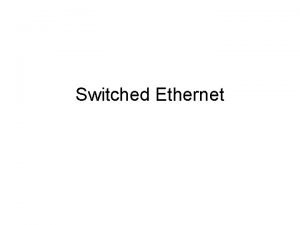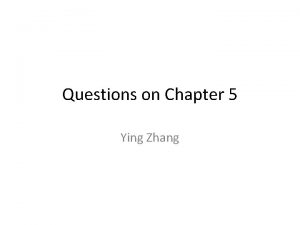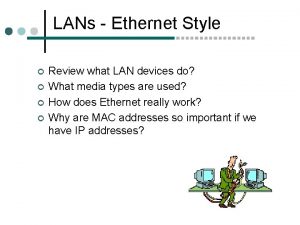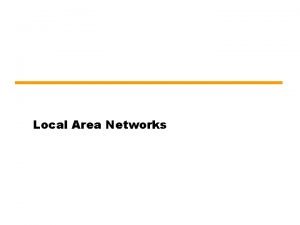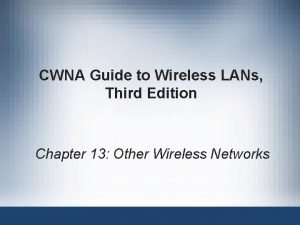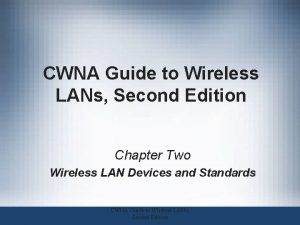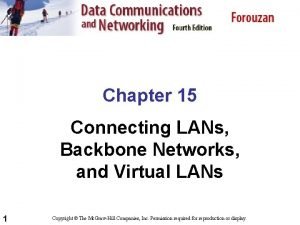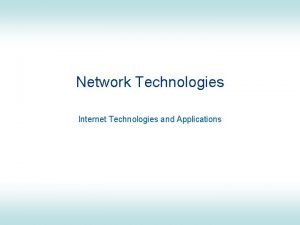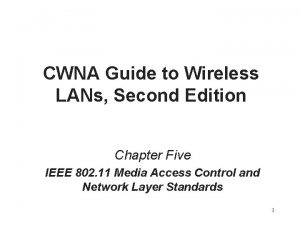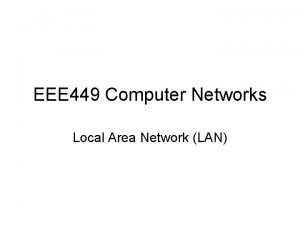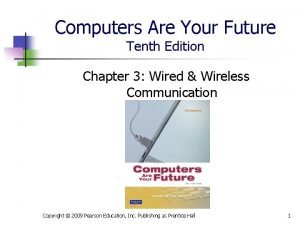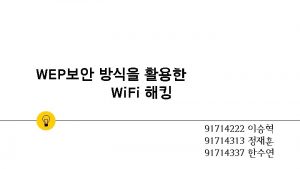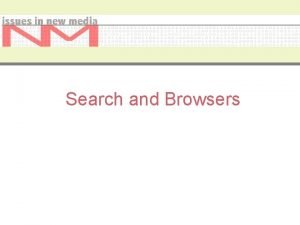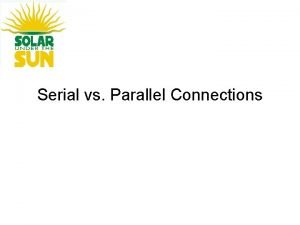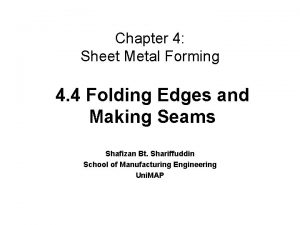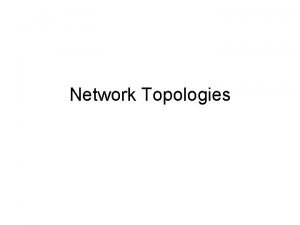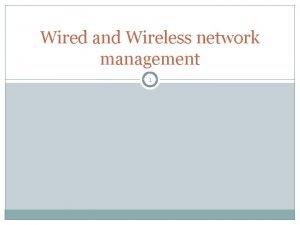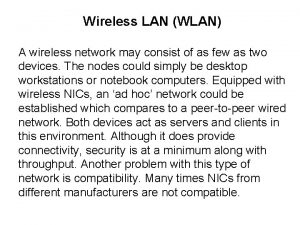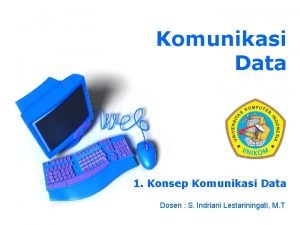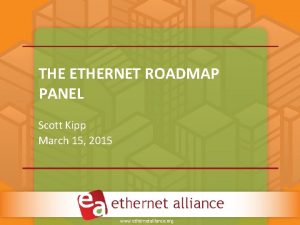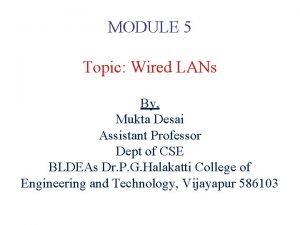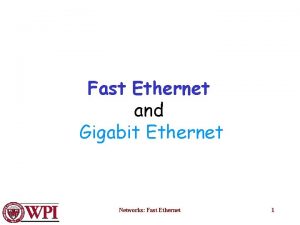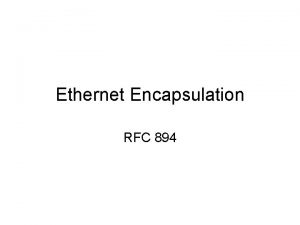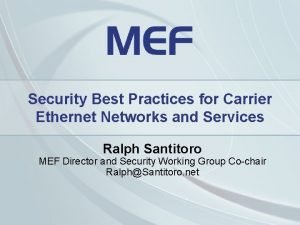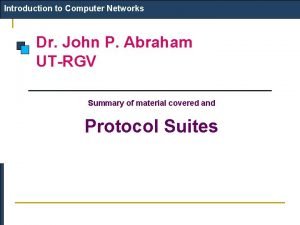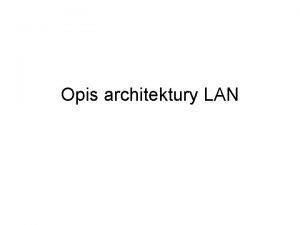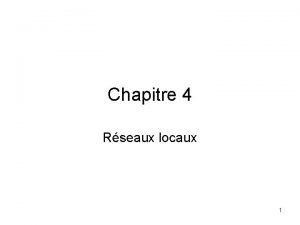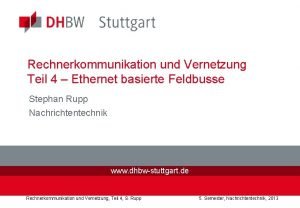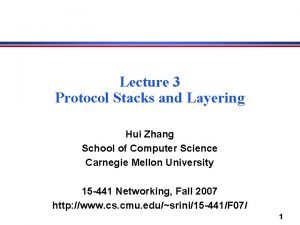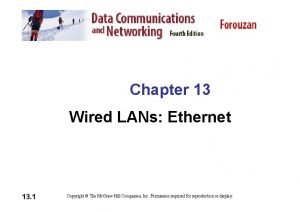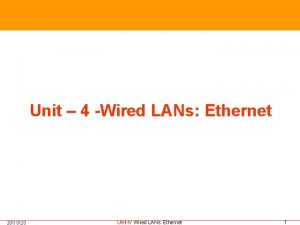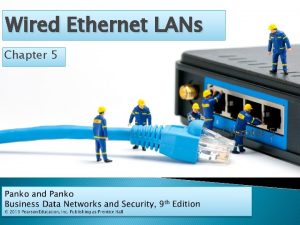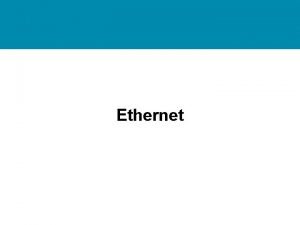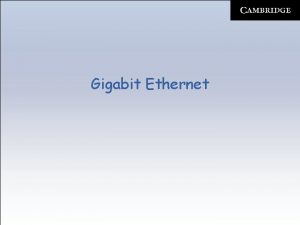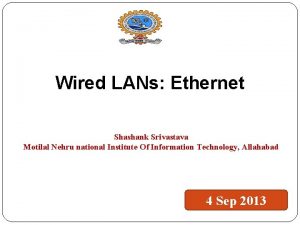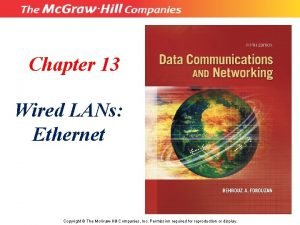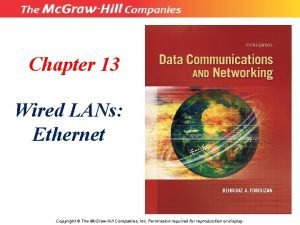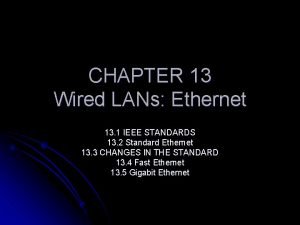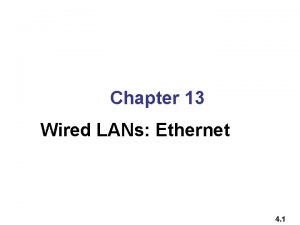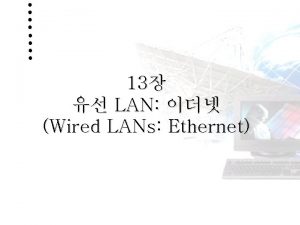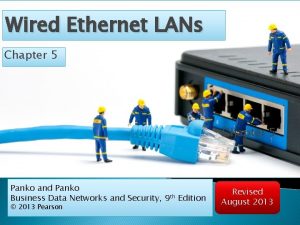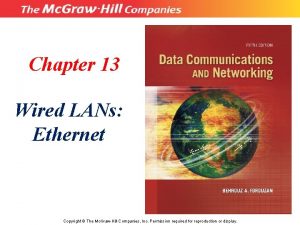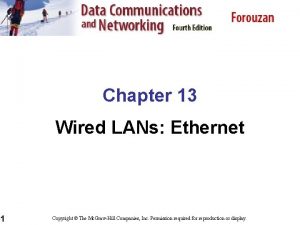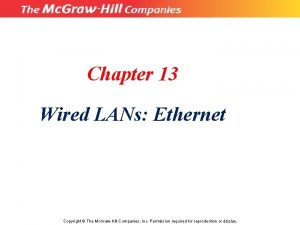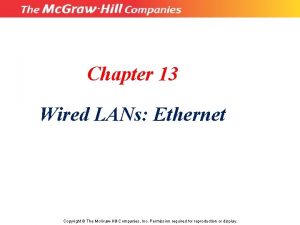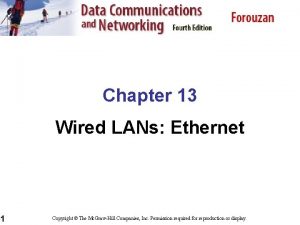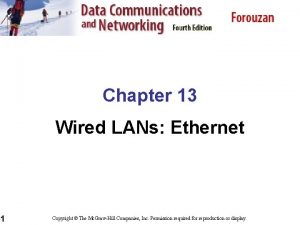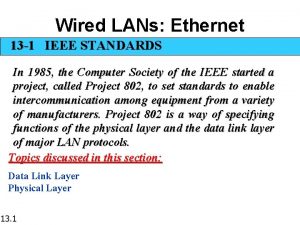3 3 Wired LANs Ethernet n n n






































- Slides: 38

3. 3 Wired LANs : Ethernet n n n Local Area Network (LAN) is a computer network that is designed for a limited geographic area such as a building or a campus. there are several technologies that define a different type of LAN : Ethernet, Token Ring, Token Bus, FDDI and ATM LAN. An IEEE Standard Project 802, was designed to regulate the manufacturing and interconnectivity between different LANs. In 1985, the Computer Society of the IEEE started a project, called Project 802, to set standards to enable intercommunication among equipment from a variety of manufacturers. Project 802 is a way of specifying functions of the physical layer and the data link layer of major LAN protocols. the IEEE has subdivided the data link layer into two sub-layers : Logical Link Control (LLC) and Media Access Control (MAC) also created several physical layer standards for different LAN protocols BENG 4522 Data Communications & Computer Networks Chapter 3 : Internetworking 1

3. 3 Wired LANs : Ethernet n IEEE standard for LANs BENG 4522 Data Communications & Computer Networks Chapter 3 : Internetworking 2

3. 3 Wired LANs : Ethernet n Logical Link Control q n to provide flow and error control for the upper-layer protocols that actually demand these services. Media Access Control (MAC) q q defines the specific access method for each LAN. Ex : defines the CSMA/CD as the media access method for Ethernet LANs, token passing method for Token Ring and Token Bus LANs. n n CSMA/CD : carrier sense multiple access with collision detection requires that each station first listen to the medium (or check the state of the medium) before sending BENG 4522 Data Communications & Computer Networks Chapter 3 : Internetworking 3

3. 3 Wired LANs : Ethernet n IEEE 802 Working Group BENG 4522 Data Communications & Computer Networks Chapter 3 : Internetworking 4

3. 3 Wired LANs : Ethernet n Standard Ethernet q The original Ethernet was created in 1976 at Xerox’s Palo Alto Research Center (PARC). Since then, it has gone through four generations BENG 4522 Data Communications & Computer Networks Chapter 3 : Internetworking 5

3. 3. 1 Ethernet LAN : Standard Ethernet n MAC Sub-layer in Standard Ethernet q q n the MAC sub-layer governs the operation of the access method. frames the data received from the upper layer and passes them to the physical layer. Frame Format in Standard Ethernet q q the Ethernet frame contains seven fields as follow : preamble : alert the receiving system to the coming frame and enabling it to synchronize its input timing. BENG 4522 Data Communications & Computer Networks Chapter 3 : Internetworking 6

3. 3. 1 Ethernet LAN : Standard Ethernet n Frame Format in Standard Ethernet q q q SFD (Start Frame Delimiter) : signals the beginning of a frame. Warns the receiving station the last chance for synchronization. DA (Destination Address : physical address of the destination. SA (Source Address) : physical address of the sender. Length or type : define the number of bytes in the data field. Data : carries data from the upper layer. CRC : error detection information. BENG 4522 Data Communications & Computer Networks Chapter 3 : Internetworking 7

3. 3. 1 Ethernet LAN : Standard Ethernet n Frame Length in Standard Ethernet q q a maximum length restriction helps to reduce the size of buffer (limited memory capacity). prevents one station from monopolizing the shared medium, blocking other stations that have data to send. BENG 4522 Data Communications & Computer Networks Chapter 3 : Internetworking 8

3. 3. 1 Ethernet LAN : Standard Ethernet n Addressing in Standard Ethernet q q q each station on an Ethernet network (PC, workstation, printer etc) has its own network interface card (NIC). the NIC provides the station with a 6 -bytes physical address as follow : a source address is always a unicast address – the frame comes from only one station. the destination address can be unicast, multicast or broadcast the broadcast destination address is a special case of multicast – all stations in the LAN are the recipients and all bits are 1 s. BENG 4522 Data Communications & Computer Networks Chapter 3 : Internetworking 9

3. 3. 1 Ethernet LAN : Standard Ethernet n Addressing in Standard Ethernet q Ex : Define the type of the following destination address : 1. 4 A : 30 : 10 : 21 : 10 : 1 A 2. 47 : 20 : 1 B : 2 E : 08 : EE 3. FF : FF : FF n Physical Layer in Standard Ethernet q defines several physical layer implementations, 4 of the most common : BENG 4522 Data Communications & Computer Networks Chapter 3 : Internetworking 10

3. 3. 1 Ethernet LAN : Standard Ethernet n Encoding and Decoding at Physical Layer q q q all standard implementations use digital signaling (baseband) at 10 Mbps. at the sender, data are converted to a digital signal using the Manchester scheme. at the receiver, the received signal is interpreted as Manchester and decoded into data BENG 4522 Data Communications & Computer Networks Chapter 3 : Internetworking 11

3. 3. 1 Ethernet LAN : Standard Ethernet n 10 Base 5 : Thick Ethernet (Thicknet) q q q the cable is too stiff to bend by hands use a bus topology with an external transceiver (transmitter/receiver) connected via a tap to a thick coaxial cable. transceiver is responsible for transmitting, receiving and detecting collisions. the transceiver is connected to the station via a transceiver cable that provides separate paths for sending and receiving. maximum length is 500 m to prevent signal de-gradation. in the case of more than 500 m, repeaters can be used up to 5 segments. BENG 4522 Data Communications & Computer Networks Chapter 3 : Internetworking 12

3. 3. 1 Ethernet LAN : Standard Ethernet n 10 Base 2 : Thin Ethernet (Cheapernet) q q uses a bus topology, with much thinner and flexible cable. the transceiver is normally part of the Network Interface Card (NIC), which is installed inside the station. more cost effective than the 10 Base 5 + simpler installation. length of each segment < 185 m (~200 m) due to high level of attenuation in thin coaxial cable. BENG 4522 Data Communications & Computer Networks Chapter 3 : Internetworking 13

3. 3. 1 Ethernet LAN : Standard Ethernet n 10 Base-T : Twisted-Pair Ethernet q q q uses a physical star topology – the stations are connected to a hub via two pairs of twisted cable create two paths – one for sending and one for receiving between the station and the hub. the maximum length is defined as 100 m, to minimize the effect of attenuation in the twisted cable. BENG 4522 Data Communications & Computer Networks Chapter 3 : Internetworking 14

3. 3. 1 Ethernet LAN : Standard Ethernet n 10 Base – F : Fiber Ethernet q q uses a star topology to connect stations to a hub. the stations are connected to the hub using two fiber-optic cables. BENG 4522 Data Communications & Computer Networks Chapter 3 : Internetworking 15

3. 3. 1 Ethernet LAN : Standard Ethernet n Summary of Standard Ethernet Physical Layer Implementations BENG 4522 Data Communications & Computer Networks Chapter 3 : Internetworking 16

3. 3. 2 Technology Changes in the Standard Ethernet n n n the 10 -Mbps Standard Ethernet has gone through several changes before moving to the higher data rates. the changes open lead to the evolution of the Ethernet to become compatible with other high-data-rate LANs. Bridged Ethernet q q division of a LAN by bridges. 2 effects of bridges : 1. raise the bandwidth 2. separate collision domains BENG 4522 Data Communications & Computer Networks Chapter 3 : Internetworking 17

3. 3. 2 Technology Changes in the Standard Ethernet n Switched Ethernet : N-port Bridge q Faster handling of the packets. BENG 4522 Data Communications & Computer Networks Chapter 3 : Internetworking 18

3. 3. 2 Technology Changes in the Standard Ethernet n Full-Duplex Ethernet q q Use two link between the station and switch, one to transmit and one to receive. No need for CSMA/CD-each station or switch can send and receive independently without worrying about collision. BENG 4522 Data Communications & Computer Networks Chapter 3 : Internetworking 19

3. 3. 3 Fast Ethernet n Under the name of IEEE 802. 3 u q q n MAC Sublayer q q n Upgrade the data rate to 100 Mbps Make it compatible with Standard Ethernet Keep the same 48 -bit address and the same frame format Keep the same min. and max. frame length CSMA/CD for the half-duplex approach No need for CSMA/CD for full-duplex Fast Ethernet Auto-negotiation q allow two devices to negotiate the mode or data rate of operation BENG 4522 Data Communications & Computer Networks Chapter 3 : Internetworking 20

3. 3. 3 Fast Ethernet n Topology n Implementation BENG 4522 Data Communications & Computer Networks Chapter 3 : Internetworking 21

3. 3. 3 Fast Ethernet n Encoding BENG 4522 Data Communications & Computer Networks Chapter 3 : Internetworking 22

3. 3. 3 Fast Ethernet n Summary BENG 4522 Data Communications & Computer Networks Chapter 3 : Internetworking 23

3. 3. 4 Gigabit Ethernet n Under the name of IEEE 802. 3 z q q q n Upgrade the data rate to 1 Gbps Make it compatible with Standard or Fast Ethernet Keep the same 48 -bit address and the same frame format Keep the same min. and max. frame length Support autonegotiation as defined in Fast Ethernet MAC sublayer q q Most of all implementations follows full-duplex approach In the full-duplex mode of Gigabit Ethernet, there is no collision; the maximum length of the cable is determined by the signal attenuation in the cable. BENG 4522 Data Communications & Computer Networks Chapter 3 : Internetworking 24

3. 3. 4 Gigabit Ethernet n Topology BENG 4522 Data Communications & Computer Networks Chapter 3 : Internetworking 25

3. 3. 4 Gigabit Ethernet n Implementation n Encoding BENG 4522 Data Communications & Computer Networks Chapter 3 : Internetworking 26

3. 3. 4 Gigabit Ethernet n Summary BENG 4522 Data Communications & Computer Networks Chapter 3 : Internetworking 27

3. 3. 5 Ten-Gigabit Ethernet n Under the name of IEEE 802. 3 ae q q q n Upgrade the data rate to 10 Gbps Make it compatible with Standard, Fast, and Giga Ethernet Keep the same 48 -bit address and the same frame format Keep the same min. and max. frame length Allow the interconnection of existing LANs into a MAN or WAN Make Ethernet compatible with Frame Relay and ATM MAC sublayer: Only in full-duplex mode : no CSMA/CD BENG 4522 Data Communications & Computer Networks Chapter 3 : Internetworking 28

3. 4 Wireless LANs n n IEEE has defined the specifications for a wireless LAN, called IEEE 802. 11, which covers the physical and data link layers. The standard defines two kinds of services : q q Basic service set (BSS) Extended service set (ESS) BENG 4522 Data Communications & Computer Networks Chapter 3 : Internetworking 29

3. 4. 1 Wireless LANs : Basic service set (BSS) n n IEEE 802. 11 defines the basic service set (BSS) as the building block of a wireless LAN made of stationary or mobile wireless stations and optional central base station known as the access point (AP) BENG 4522 Data Communications & Computer Networks Chapter 3 : Internetworking 30

3. 4. 1 Wireless LANs : Basic service set (BSS) n n n BSS without an AP is a stand-alone network and cannot send data to other BSSs (other set of BSS) – ad hoc architecture (ad hoc network) In ad hoc architecture BSS, stations can form a network without the need of an AP, can locate one another and agree to be part of BSS with an AP – infrastructure network BENG 4522 Data Communications & Computer Networks Chapter 3 : Internetworking 31

3. 4. 2 Wireless LANs : Extended service set (ESS) n n n made up of two or more BSSs with APs the BSSs are connected through a distribution system, which is usually a wired LAN the distribution system connect the APs in the BSSs BENG 4522 Data Communications & Computer Networks Chapter 3 : Internetworking 32

3. 4. 2 Wireless LANs : Extended service set (ESS) n IEEE 802. 11 defines 3 types of stations based on their mobility in a wireless LAN q q q n n n No-transition mobility BSS-transition mobility ESS-transition mobility No transition mobility – a station is either stationary (not moving) or moving only inside a BSS-transition mobility – can move from one BSS to another, but limited inside one ESS-transition mobility – can move from one ESS to another, but no guarantee on continuous communication during the movement BENG 4522 Data Communications & Computer Networks Chapter 3 : Internetworking 33

3. 4. 3 Wireless LANs : Fragmentation n Wireless environment is very noisy, a corrupt frame has to be retransmitted Large frame is divided into smaller frames (more efficient to resend a small frame than a large one) Frame types – management frame, control frame and data frame q q q n n n Management frame Control frame Data frame Management frame – used for the initial communication between stations and access points Control frames– used for accessing the channel and acknowledging frames Data frame – used for carrying data and control information BENG 4522 Data Communications & Computer Networks Chapter 3 : Internetworking 34

3. 4. 3 Wireless LANs : Fragmentation n Frame Format BENG 4522 Data Communications & Computer Networks Chapter 3 : Internetworking 35

3. 4. 3 Wireless LANs : Fragmentation n Frame format n D – defines the duration of the transmission that it needs to occupy the channel / ID of the frame (for control frame) Addresses – define the source and destination SC (sequence control) – defines the sequence number of the frame (in flow control) Frame body – contains information base on the type and subtype defined in the FC field FCS (Frame Check Sequence) – contains a CRC-32 error detection sequence n n BENG 4522 Data Communications & Computer Networks Chapter 3 : Internetworking 36

3. 4. 4 Wireless LANs : Physical Layer n Six specifications defined for wireless LANs physical layer n All (except infrared) operate in the industrial, scientific and medical (ISM) band which defines 3 unlicensed bands in the three ranges : 902 – 928 MHz, 2. 400 – 4. 835 GHz and 5. 725 – 5. 850 GHz BENG 4522 Data Communications & Computer Networks Chapter 3 : Internetworking 37

3. 4. 4 Wireless LANs : Physical Layer n n n FHSS – frequency-hopping spread spectrum DSSS – direct sequence spread spectrum OFDM – orthogonal frequency-division multiplexing BENG 4522 Data Communications & Computer Networks Chapter 3 : Internetworking 38
 Lans
Lans Wired lans
Wired lans Switched ethernet vs shared ethernet
Switched ethernet vs shared ethernet Consider three lans interconnected by two routers
Consider three lans interconnected by two routers Lans style
Lans style Adam lans
Adam lans High speed lans
High speed lans Cwna guide to wireless lans 3rd edition
Cwna guide to wireless lans 3rd edition Cwna guide to wireless lans
Cwna guide to wireless lans Connecting lans
Connecting lans Internet technologies and applications
Internet technologies and applications Cwna guide to wireless lans
Cwna guide to wireless lans Lan
Lan Wired vs wireless broadband
Wired vs wireless broadband Tenth chapter wired
Tenth chapter wired 06 91714313
06 91714313 Steven levy wired
Steven levy wired Parallel vs series batteries
Parallel vs series batteries Wired edge
Wired edge Star wired ring topology
Star wired ring topology Understanding wired and wireless networks
Understanding wired and wireless networks What does a wireless lan (wlan) act as to a wired network?
What does a wireless lan (wlan) act as to a wired network? Kepanjangan dari utp pada media wired adalah
Kepanjangan dari utp pada media wired adalah Wired media and wireless media
Wired media and wireless media Ethernet roadmap
Ethernet roadmap Mukta desai
Mukta desai Fast ethernet in computer networks
Fast ethernet in computer networks Carrier extension in gigabit ethernet
Carrier extension in gigabit ethernet Rfc 894
Rfc 894 Carrier ethernet security
Carrier ethernet security Components of computer network
Components of computer network Serial 0
Serial 0 Opartra
Opartra Trame
Trame Ethernet switch funktionsweise
Ethernet switch funktionsweise Unrecognized device rslinx
Unrecognized device rslinx Ethernet driver
Ethernet driver Gigabit ethernet u/ddm
Gigabit ethernet u/ddm First ethernet
First ethernet
